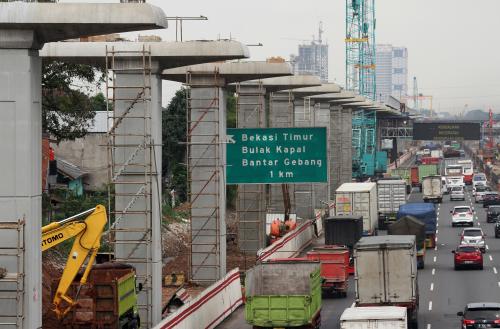Content from the Brookings Institution India Center is now archived. After seven years of an impactful partnership, as of September 11, 2020, Brookings India is now the Centre for Social and Economic Progress, an independent public policy institution based in India.
We are told early in life that we cannot both have our cake and eat it, too. Of course, this is taught to us before we take our first economics course. There, we are introduced to the “production possibility frontier”, which traces the combination of goods that an economy can produce when its resources are being used with maximum efficiency. When this happens, of course, the cake aphorism makes sense. You can only get more of something by giving up a quantity of something else. But this happens only when the economy is operating on the frontier. When it is not, implying that resources are not being used efficiently, it can actually produce more of everything with the same resources.
Nobody would characterise the Indian economy – or for that matter, any economy – as operating on the frontier. Consequently, there are opportunities to get more out of existing resources. This argument could be applied to any number of policy questions, but the most critical one facing the government as it prepares to present its Budget this week is infrastructure.
The backdrop is well-known.The public-private-partnership (PPP) model for infrastructure development is dysfunctional. The record of delivery, let alone on-time and within budget, is extremely weak. Where there has been successful completion – for example, power or ports – the absence of linkages has undermined the viability of ventures. At this point, the capacity of private infrastructure development to deliver on existing commitments, let alone take on new ones, is severely constrained. They are heavily leveraged and their equity is hugely discounted. Infrastructure accounts for a significant proportion of the non-performing assets (NPAs) of banks.
What needs to be emphasised, and repeatedly so, is that no matter what the other policy stimuli to growth may be, the capacity to accelerate and sustain growth will be severely constrained if expansion in infrastructure capacity does not take place substantially and quickly. Even as the government launches several initiatives – “Make In India”, the prime minister’s Jan Dhan Yojana, Skilling India, Digital India – the potential impact of all of these on investment, employment and growth will be severely constrained by the stasis that now plagues infrastructure.
This concern has, unsurprisingly, led to an intense debate. The premise that there is no option other than to step up public investment in infrastructure is now virtually unanimously accepted. But how this is to be done is a contentious question. Should the commitment to fiscal consolidation be diluted? If not, where are the resources going to come from?
This is where the “having your cake and eating it, too” opportunity comes into play. We traditionally view public finances in income-expenditure terms. This is limiting. The government has a huge balance sheet, which remains completely in the background of the policy debate. The solution to the funding constraint lies in taking a balance-sheet view.
The suggestion here is to set up a national infrastructure fund (NIF). This will function like a venture capital fund, but with funds mobilised by government. Current budgetary commitments to investment in infrastructure could be channelised into the fund as equity. Further, all asset sales, whether through disinvestment, spectrum sales or mining licences, should be transferred to this entity as equity. This means that the government is prudently preserving its balance sheet by using the sale of some assets to create new ones, rather than using the proceeds to finance consumption expenditure.
The equity so provided can be leveraged three or four multiples. To do this, debt can be taken on in three tiers, in sequence.
(1) Sovereign debt (or guarantee): The initial borrowing can be made in the form of sovereign debt instruments. This will add to the debt-gross domestic product ratio, which will have negative sovereign rating implications, but if the overall plan is articulated well and the funds are clearly being used for infrastructure, these risks can be contained. Rating agency concerns are highest when the debt is being expanded to fund general revenue expenditure. They are likely to be somewhat assuaged if the debt is being credibly used to finance infrastructure investment and if repayments are expected to come from the returns on these investments.
(2) Credit enhancement: The next stage would be to provide credit enhancement to bonds issued by the NIF. This would allow insurance and pension funds, both domestic and foreign, to invest in these securities. The cost of enhancement could be borne by the Budget for some period of time.
(3) Direct market bond issuance: As the plan unfolds and builds credibility, the NIF can issue its own bonds, which will have no direct fiscal implications as long as it is clearly communicated to investors that the government is not guaranteeing these bonds.
To supplement this structure, additional pools can also be looked at. There is much talk of the large cash holdings of several public enterprises, which should be seen as investible resources. Instead of using these to fund the Budget deficit, they could be used to buy the bonds issued by the NIF.
The first priority of the new fund will be to take some critical projects that are currently on the shelf as non-performing assets on banks’ loan books. All infrastructure projects are important, but some are more important than others on account of their multiple linkages with others. These “nodal” projects need to be identified and accelerated. Those that are stalled because of their NPA status need to be transferred to the new entity, as a price that balances the interests of the banks and the shareholders. In the bargain, both may have to sell at a discount, or at the very least, postpone the realisation of their gains.
The final piece of the solution is the execution component. I would argue that the PPP model seems to work, if at all, when the role of the private sector is predominantly execution of projects. In effect, incumbent promoters of projects that are already under way could restructure their contracts from the current form to become engineering-procurement-construction (EPC) service providers.
This proposal may sound like a stretch. It will certainly not materialise overnight, given the complexities involved in both the financial structure and the negotiations with banks and private sector promoters. But let it be kept in mind that there is no meaningful alternative on the table at this point.
—
This column first appeared in Business Standard, on February 23, 2015. Like other products of the Brookings Institution India Center, this is intended to contribute to discussion and stimulate debate on important issues. The views are those of the author.
Image Source: Flickr



Commentary
Op-edHaving your cake…
Business Standard
February 23, 2015